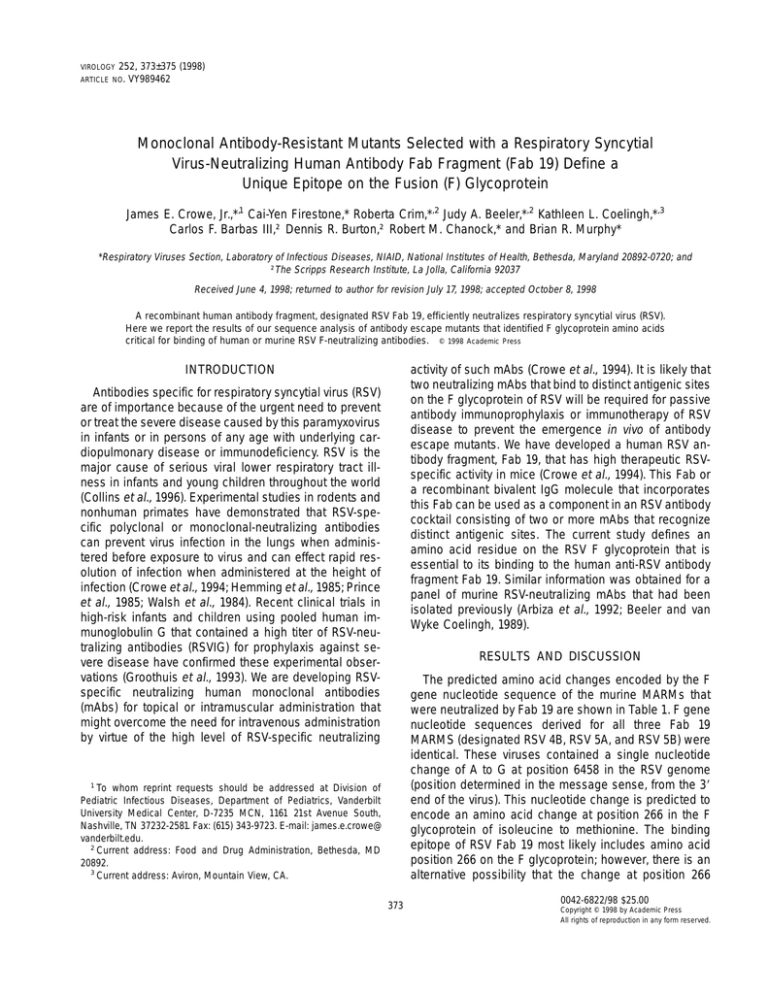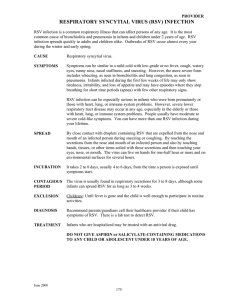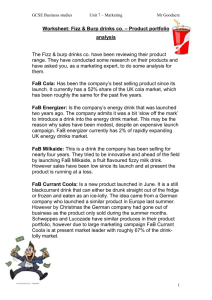Monoclonal Antibody-Resistant Mutants Selected with a Respiratory Syncytial
advertisement

VIROLOGY 252, 373±375 (1998) VY989462 ARTICLE NO. Monoclonal Antibody-Resistant Mutants Selected with a Respiratory Syncytial Virus-Neutralizing Human Antibody Fab Fragment (Fab 19) Define a Unique Epitope on the Fusion (F) Glycoprotein James E. Crowe, Jr.,*,1 Cai-Yen Firestone,* Roberta Crim,*,2 Judy A. Beeler,*,2 Kathleen L. Coelingh,*,3 Carlos F. Barbas III,² Dennis R. Burton,² Robert M. Chanock,* and Brian R. Murphy* *Respiratory Viruses Section, Laboratory of Infectious Diseases, NIAID, National Institutes of Health, Bethesda, Maryland 20892-0720; and ²The Scripps Research Institute, La Jolla, California 92037 Received June 4, 1998; returned to author for revision July 17, 1998; accepted October 8, 1998 A recombinant human antibody fragment, designated RSV Fab 19, efficiently neutralizes respiratory syncytial virus (RSV). Here we report the results of our sequence analysis of antibody escape mutants that identified F glycoprotein amino acids critical for binding of human or murine RSV F-neutralizing antibodies. © 1998 Academic Press activity of such mAbs (Crowe et al., 1994). It is likely that two neutralizing mAbs that bind to distinct antigenic sites on the F glycoprotein of RSV will be required for passive antibody immunoprophylaxis or immunotherapy of RSV disease to prevent the emergence in vivo of antibody escape mutants. We have developed a human RSV antibody fragment, Fab 19, that has high therapeutic RSVspecific activity in mice (Crowe et al., 1994). This Fab or a recombinant bivalent IgG molecule that incorporates this Fab can be used as a component in an RSV antibody cocktail consisting of two or more mAbs that recognize distinct antigenic sites. The current study defines an amino acid residue on the RSV F glycoprotein that is essential to its binding to the human anti-RSV antibody fragment Fab 19. Similar information was obtained for a panel of murine RSV-neutralizing mAbs that had been isolated previously (Arbiza et al., 1992; Beeler and van Wyke Coelingh, 1989). INTRODUCTION Antibodies specific for respiratory syncytial virus (RSV) are of importance because of the urgent need to prevent or treat the severe disease caused by this paramyxovirus in infants or in persons of any age with underlying cardiopulmonary disease or immunodeficiency. RSV is the major cause of serious viral lower respiratory tract illness in infants and young children throughout the world (Collins et al., 1996). Experimental studies in rodents and nonhuman primates have demonstrated that RSV-specific polyclonal or monoclonal-neutralizing antibodies can prevent virus infection in the lungs when administered before exposure to virus and can effect rapid resolution of infection when administered at the height of infection (Crowe et al., 1994; Hemming et al., 1985; Prince et al., 1985; Walsh et al., 1984). Recent clinical trials in high-risk infants and children using pooled human immunoglobulin G that contained a high titer of RSV-neutralizing antibodies (RSVIG) for prophylaxis against severe disease have confirmed these experimental observations (Groothuis et al., 1993). We are developing RSVspecific neutralizing human monoclonal antibodies (mAbs) for topical or intramuscular administration that might overcome the need for intravenous administration by virtue of the high level of RSV-specific neutralizing RESULTS AND DISCUSSION The predicted amino acid changes encoded by the F gene nucleotide sequence of the murine MARMs that were neutralized by Fab 19 are shown in Table 1. F gene nucleotide sequences derived for all three Fab 19 MARMS (designated RSV 4B, RSV 5A, and RSV 5B) were identical. These viruses contained a single nucleotide change of A to G at position 6458 in the RSV genome (position determined in the message sense, from the 39 end of the virus). This nucleotide change is predicted to encode an amino acid change at position 266 in the F glycoprotein of isoleucine to methionine. The binding epitope of RSV Fab 19 most likely includes amino acid position 266 on the F glycoprotein; however, there is an alternative possibility that the change at position 266 1 To whom reprint requests should be addressed at Division of Pediatric Infectious Diseases, Department of Pediatrics, Vanderbilt University Medical Center, D-7235 MCN, 1161 21st Avenue South, Nashville, TN 37232-2581. Fax: (615) 343-9723. E-mail: james.e.crowe@ vanderbilt.edu. 2 Current address: Food and Drug Administration, Bethesda, MD 20892. 3 Current address: Aviron, Mountain View, CA. 373 0042-6822/98 $25.00 Copyright © 1998 by Academic Press All rights of reproduction in any form reserved. 374 CROWE ET AL. TABLE 1 RSV Monoclonal Antibody-Resistant Mutants (MARMs) Selected with the Human Recombinant Fab 19 Contain a Predicted Amino Acid Change from the Wild-Type Sequence that Differs from Changes Found in Mutants Selected with Murine mAbs Mutation in RSV F glycoprotein Nucleotide Antibody used to select MARM Murine 1237 1214 1129 151 1200 1142 MARM selected with indicated mAbsa v1237 v1214 v1129 v151 v1200 v1142 1153 1269 1308F v1153 v1269 v1308F 1302A v1302A RSV 19b C4848 Human Fab 19 Fab 19 Fab 19 4B 5A 5B Amino acid Position(s) Codon change wild-type A2 3 MARM Position(s) AA change wild-type A2 3 MARM 839 839 837 829 829 108 829 798 1179 735 1275 735 1275 1298c AAC 3 TAC AAC 3 TAC TCC 3 TTC AAG 3 AAT AAG 3 AAT TTT 3 TCT AAG 3 AAT AAT 3 AGT CCC 3 CAC GCA 3 GTA AAA 3 ACA GCA 3 GTA AAA 3 AGA CGT 3 AGT 276 276 275 272 272 32 272 262 389 241 421 241 421 429 Asn 3 Tyr Asn 3 Tyr Ser 3 Phe Lys 3 Asn Lys 3 Asn Phe 3 Ser Lys 3 Asn Asn 3 Ser Pro 3 His Ala 3 Val Lys 3 Thr Ala 3 Val Lys 3 Arg Arg 3 Ser [ [ [ 811 811 811 [ [ [ ATA 3 ATG ATA 3 ATG ATA 3 ATG [ [ [ 266 266 266 [ [ [ Ile 3 Met Ile 3 Met Ile 3 Met a All mutants were derived from the RSV wild-type strain A2. The similarity in numerical designation of Fab 19 is fortuitous; the murine mAb 19 is not related to the human Fab 19. c Previously determined sequence change (Arbiza et al., 1992). b causes a conformational alteration of the protein that abolishes binding of the Fab at a different site that does not include the amino acid 266. The region of the F glycoprotein in which amino acid 266 is located is quite interesting in that all of the MARMs derived by selection with site A neutralizing murine mAbs were determined to contain an amino acid substitution between residues 262 and 276. However, MARMs selected by murine mAbs did not contain a predicted amino acid change at position 266. Interestingly, Fab 19 neutralizes MARMs containing a change at nearby amino acid position 262, 272, 275, or 276, but competition analysis had suggested previously that Fab 19 was directed at a distinct antigenic site (Barbas et al., 1992). It is possible that the lack of competition of the human Fab fragments against whole mouse immunoglobulin molecules in the competition binding assay is a function of the smaller size of the Fab. Several nucleotide substitutions could result in an amino acid change at position 266; however, the same A-to-G substitution was found in three instances. The reason for this finding is not clear. One possibility is that a mutant virus was present in the wild-type parent virus pool at an undetectable level and virus passages in the presence of Fab enriched for the growth of this mutant, rather than independently selecting three mutants de novo during antibody-treated passages. In summary, we have identified an amino acid residue on the RSV F glycoprotein that is essential to binding for the first isolated RSV-neutralizing human mAb. This residue is near other residues important for binding a panel of murine RSV mAbs. The Fab 19 holds promise as an important component of an antibody preparation for immunoprophylaxis or immunotherapy of RSV disease in humans (Crowe et al., 1994). MATERIALS AND METHODS The human Fab 19, previously cloned from a combinatorial phage display library, was expressed in Escherichia coli and then purified from crude cell lysates by immunoaffinity chromatography using an anti-human Fab antibody as described previously (Barbas et al., 1992; Crowe et al., 1994). Purified RSV Fab 19 was analyzed for its ability to neutralize the RSV A2/HEK-7 wildtype virus (Connors et al., 1995) and each of 11 viruses in a panel of previously described MARMs selected for resistance to neutralization by the various murine mAbs listed in Table 1 (Arbiza et al., 1992; Beeler and van Wyke Coelingh, 1989). The Fab 19 neutralized the wild-type RSV FUSION GP NEUTRALIZATION AB EPITOPE parent and each of the MARMS with a high level of specific activity (,1 mg/ml). Three independently derived MARMs were isolated from the RSV A2 wild-type virus, each by a separate passage series in which virus was selected two times by growth in the presence of the human Fab 19 at a concentration of 30 mg/ml, and then amplified by growth in the absence of Fab 19. Each of three independently derived virus suspensions derived in this manner was biologically cloned by three plaque passages. The MARMs so selected were shown to resist complete neutralization with Fab 19 in cell culture. For example, the titer of the RSV A2 wild-type virus was reduced by 5.7 log10 PFU/ml after incubation with 150 mg/ml Fab compared with PBS control, whereas the titer of each of the Fab 19-selected MARMs was reduced by ,10-fold. The MARMs were reduced in plaque titer in repeated tests on average by 3- to 4-fold after incubation with Fab 19 compared with incubation with PBS. It is not known whether this represents a virus specific effect, but this reduction falls within the expected range of variability of the plaque assay. Viral RNA from each of the MARMs was prepared from virus-infected LLC-MK2 or HEp-2 cell monolayer cultures as described (Connors et al., 1995). The RNA was reversed transcribed into cDNA and the F protein gene was amplified by PCR using gene-specific primers, cloned into a plasmid vector or, in some cases, the replicative form of phage M13mp19, and sequenced by the dideoxynucleotide method using either plasmid or RSV F gene-specific sequencing primers and T7 polymerase (Sequenase; U.S. Biochemical, Cleveland, OH) as described previously (Connors et al., 1995). Consensus sequences were determined by sequencing cDNA clones derived from at least two independent PCRs. Differences between the observed sequences and that of the previously determined parental virus RSV A2/ HEK-7 were confirmed by sequencing two or more clones in both forward and reverse directions. The previously described RSV antibody escape mutant C4848 (also designated v324 in the previous publication), which contains a single nucleotide change in the F glycoprotein 375 that encodes a predicted amino acid change at amino acid position 429 from the N-terminus (Arbiza et al., 1992), was kindly supplied by Dr. Geraldine Taylor (AFRC Institute for Animal Health, Compton, U.K.). REFERENCES Arbiza, J., Taylor, G., Lopez, J. A., Furze, J., Wyld, S., Whyte, P., Stott, E. J., Wertz, G., Sullender, W., and Trudel, M. (1992). Characterization of two antigenic sites recognized by neutralizing monoclonal antibodies directed against the fusion glycoprotein of human respiratory syncytial virus. J. Gen. Virol. 73, 2225±2234. Barbas, C. F., Crowe, J. E., Jr., Cababa, D., Jones, T. M., Zebedee, S. L., Murphy, B. R., Chanock, R. M., and Burton, D. R. (1992). Human monoclonal Fab fragments derived from a combinatorial library bind to respiratory syncytial virus F glycoprotein and neutralize infectivity. Proc. Natl. Acad. Sci. USA 89, 10164±10168. Beeler, J. A., and van Wyke Coelingh, K. (1989). Neutralization epitopes of the F glycoprotein of respiratory syncytial virus: Effect of mutation upon fusion function. J. Virol. 63, 2941±2950. Collins, P. L., McIntosh, K., and Chanock, R. M. (1996). In ªField's Virology,º 3rd ed. (B. N. Fields, D. M. Knipe, P. M. Howley, R. M. Chanock, J. L. Melnick, T. P. Monath, B. Roizman, and S. E. Straus, Eds.), pp 1313±1351. Lippincott-Raven Press, New York. Connors, M., Crowe, J. E., Jr., Firestone, C. Y., Murphy, B. R., and Collins, P. L. (1995). A cold-passaged, attenuated strain of human respiratory syncytial virus contains mutations in the F and L genes. Virology 208, 478±484. Crowe, J. E., Jr., Murphy, B. R., Chanock, R. M., Williamson, R. A., Barbas, C. F., III, and Burton, D. R. (1994). Recombinant human RSV monoclonal antibody Fab is effective therapeutically when introduced directly into the lungs of respiratory syncytial virus-infected mice. Proc. Natl. Acad. Sci. USA 91, 1386±1390. Groothuis, J. R., Simoes, E. A., Levin, M. J., Hall, C. B., Long, C. E., Rodriguez, W. J., Arrobio, J., Meissner, H. C., Fulton, D. R., and Welliver, R. C. (1993). Prophylactic administration of respiratory syncytial virus immune globulin to high-risk infants and young children: The Respiratory Syncytial Virus Immune Globulin Study Group. N. Engl. J. Med. 329, 1524±1530. Hemming, V. G., Prince, G. A., Horswood, R. L., London, W. J., Murphy, B. R., Walsh, E. E., Fischer, G. W., Weisman, L. E., Baron, P. A., and Chanock, R. M. (1985). Studies of passive immunotherapy for infections of respiratory syncytial virus in the respiratory tract of a primate model. J. Infect. Dis. 152, 1083±1087. Prince, G. A., Hemming, V. G., Horswood, R. L., and Chanock, R. M. (1985). Immunoprophylaxis and immunotherapy of respiratory syncytial virus infection in the cotton rat. Virus Res. 3, 193±206. Walsh, E. E., Schlesinger, J. J., and Brandriss, M. W. (1984). Protection from respiratory syncytial virus infection in cotton rats by passive transfer of monoclonal antibodies. Infect. Immunol. 43, 756±758.


